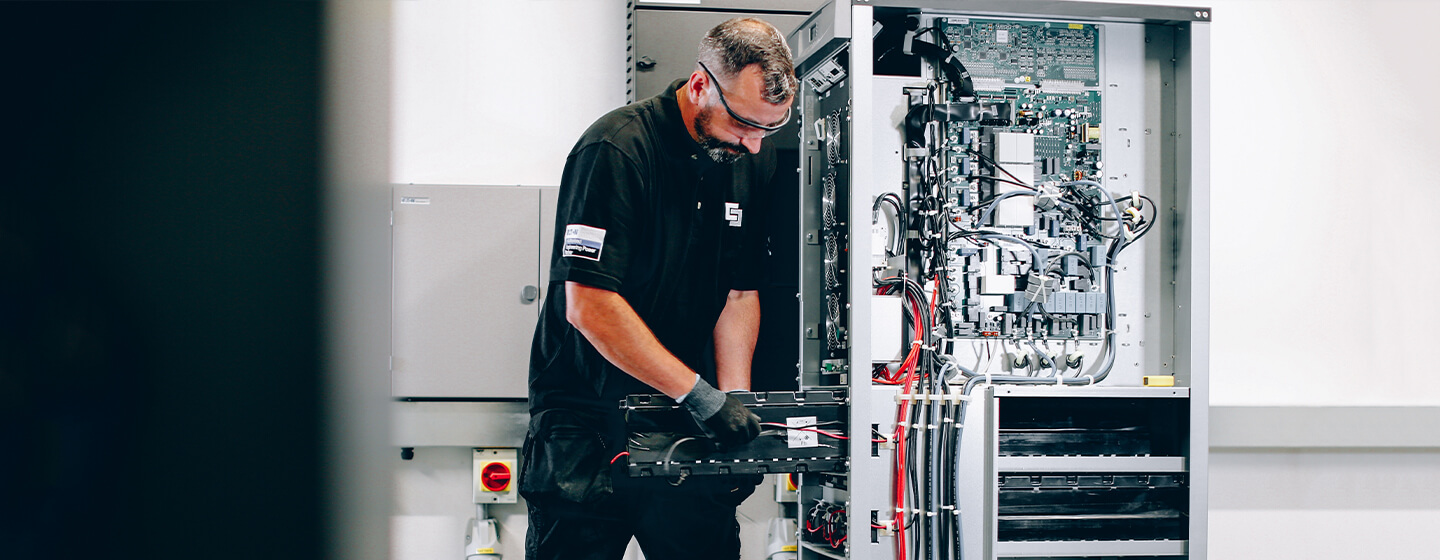- Homepage
- /
- Uncategorized
- /
- UPS Battery Maintenance Procedure
- Homepage
- /
- Uncategorized
- /
- UPS Battery Maintenance Procedure
- Homepage
- /
- Uncategorized
- /
- UPS Battery Maintenance Procedure
UPS Battery Maintenance Procedure

A damaged, corroded or diminished battery system is one of the main causes uninterruptible power supply (UPS) failure, so you must protect them. A battery maintenance procedure is the key to the long-term performance of your UPS – and security for your business. In this article we identify the key causes of battery failure and the components of a battery maintenance procedure.
Causes of Battery Failure
Batteries tend to gradually reduce power until they reach around 80% of their power rating. At this point, the decline is precipitous, with values falling rapidly until they ultimately fail.
Whether your UPS uses valve-regulated lead-acid batteries (VRLA) batteries, lithium-ion batteries or vented lead-acid (VLA) units, the battery is the most vulnerable part of your UPS. Over time every battery degrades – and it’s your job to monitor and manage that process.
There are numerous causes of battery failure, including plate separation, corrosion, internal and external short circuits, plate sufflation, excessive gassing and drying out. It’s also common for batteries to be affected by overcharging. A high overcharge current can cause corrosion and damage which can be irreparable.
The optimum ambient temperature for your UPS is between 20 – 25°C. Storing UPS battery strings at higher or lower temperatures can rapidly cause a loss of power and affect battery life and performance.
If your UPS is called into action, the stress it was placed under could affect its operation. Each discharge and recharge will reduce the relative capacity of the battery. The length of the discharge cycle varies for each battery, but when they’re beyond their operational lifespan, they require replacement.
Understanding the multiple causes of battery failure is crucial in understanding the importance of monitoring your batteries, and ensuring a battery maintenance procedure is in place.
Prevention, not cure
The operational performance, lifespan and safety of your UPS batteries can all be improved with a comprehensive management and maintenance procedure. The purpose of regularly scheduled maintenance is to monitor the condition of individual batteries and battery sets to extend the life and ensure they’re ready to perform in an emergency. The best time to identify a problem is before an emergency, not during one.
There are three fundamental parts of a comprehensive battery maintenance procedure:
1. Scheduled & preventative maintenance
2. Monitoring & management
3. Routine testing
1. Scheduled & Preventative Maintenance
To avoid costly downtime, you should maintain all batteries according to the manufacturer’s instructions. A battery service should include crucial electrical checks, to measure the UPS float voltage and open-circuit battery voltages.
You should perform a physical check of the UPS batteries to identify any potential problems. While over a decade old, the 2006 IEEE Guide for Batteries for Uninterruptible Power Supply Systems provides a comprehensive overview of scheduled maintenance.
During a maintenance procedure, trained technicians should:
- Inspect all batteries, racks, cabinets and terminals for any signs of corrosion or wear.
- Check for cracks, leaks or swelling.
- Physically inspect all connections, ensuring they meet the manufacturer’s specifications.
- Double-check the temperature of the room.
- Check the electrolyte levels in each cell.
Every inspection should be recorded, with the findings maintained. Over time, you can spot any changes or recurrent patterns that could spot problems before they happen.
2. Monitoring & Management
Manufacturers make many claims about the lifespan of batteries, but real life and design life are two different things. Continual monitoring of the condition of your UPS is essential. All current UPS systems have a remote monitoring capability, which will ensure you’re able to monitor the load level, input and output voltages, and battery voltage of your UPS.
Alerts can also be set up to monitor the temperature of the storage environment. Alarms can be configured to trigger SMS messages and emails to ensure that action is taken immediately. You should have an internal process set-up to deal with any UPS battery problems immediately.
3. Routine Testing
Routine testing is critical to monitoring the condition of your UPS batteries. Load bank testing (sometimes called a battery discharge test) safely replicates the conditions your UPS might experience when you suffer a mains outage. During the process, engineers connect a loadbank to the output of your UPS and simulate a mains failure. A load bank test can identify how your batteries will perform under real-world conditions. If the results show that battery capacity is less than 80% of its rated capacity, then it’s time to source a replacement.
Impedance testing is also used to test and monitor the internal resistance within batteries and battery sets. A current is passed through each battery in sequence to measure the internal impedance. The test can identify weak cells and degrading batteries with dwindling capacity, enabling you to repair or replace them.
Critical Process
Battery maintenance and monitoring are critical parts of ensuring your UPS will perform when it’s needed. A thorough maintenance and management process can identify problems before they escalate. Regular servicing and maintenance can extend battery life, protecting your investment.
A robust UPS battery maintenance procedure will give you – and your organisation – the peace of mind you need to know that your critical infrastructure is protected, whatever happens.




